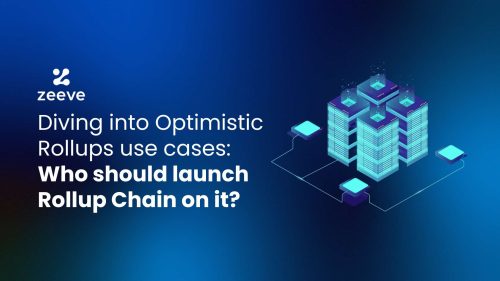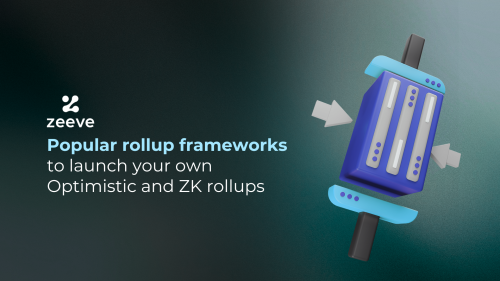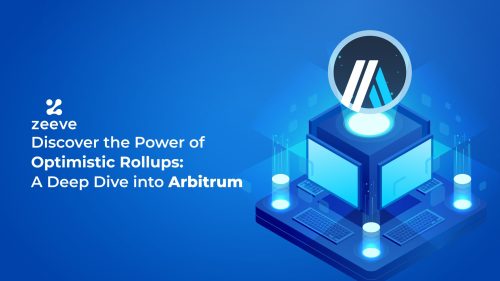
Optimistic Rollup Use Cases: Explore Custom OP Chain Applications
Given that Layer2/Layer3 rollups are an extremely viable solution to blockchain’s scalability issue, many dApps are now choosing Optimistic rollups to launch a low-cost and highly-performant ecosystem. That’s because Optimistic rollups are less complicated to implement, and they offer next-level benefits like massive scalability, high modularity, battle-tested security, and inter-rollup interoperability.
Through this article, we will explore top Optimistic rollup use cases and benefits. Basically, we will understand what kind of applications are getting built on the Optimistic rollup ecosystem.

Why should you build a custom Optimistic rollup chain?
Having your own custom Optimistic rollup chain means you can spin up your own production-grade Layer-2 rollup chain, similar to popular Optimistic rollup networks like Optimism Mainnet, Arbitrum One, Base, OP BNB Chain, Zora, Metis, and Mantle. You will have complete control over gas fee optimization, token customization, smart contracts, and many ecosystem-level parameters.
Further, an Optimistic rollup ecosystem is optimized to offer features like separate data availability other than Ethereum, censorship resistance, quick settlement of transactions due to ‘assumption,’ excellent fraud proving mechanism, a safe Layer1-based hub for verifying fraud proofs and dispute resolution, and a lot more.
Read more on Optimistic Rollups and how low-cost scalable applications are built using it.
What frameworks are commonly used to launch a custom Optimistic Rollup?
OP Stack from Optimism, Arbitrum Orbit from Arbitrum, and Rollkit are the popular frameworks for launching custom Optimistic rollups L2s/L3s.
OP Stack is a standardized, open-source, and shared rollup development stack that simplifies the process of spinning up your custom production-grade L2 chain, similar to Optimism’s OP Mainnet. Independent chains built with OP Stack, known as Superchains, share a common bridging protocol, governance system, and other components, making it a user-friendly choice.
Regarding Arbitrum Orbit, it allows projects to create their own dedicated chain that has the choice to settle to any of the Arbitrum’s Layer 2 (L2) chains– Arbitrum One, Arbitrum Nova, Arbitrum Sepolia, or Arbitrum Goerli. With your Orbit chain, you can customize the throughput, gas token, privacy, governance, and other important parameters to make it very specific.
Finally, there’s Rollkit, which is an open-source modular framework for building sovereign rollups. Rollkit empowers web3 developers to innovate and create new classes of rollups easily with very minimal tradeoffs. With Rollkit, you have the flexibility to choose your preferred rollup components, such as sequencer type, data availability layer, prover, aggregator, interoperability, etc.
Want to learn in-depth details about various frameworks that allow the development of blockchain rollups? Refer to our comprehensive guide linked below:
Various Rollup Frameworks for launching Optimistic and ZK Rollups
Who should build a custom L2/L3 Optimistic rollup chain? Let’s deep dive into some use cases
A tailor-made, specific, Optimistic rollup chain is suited for a range of web3 projects and dApps, from DeFi to gaming and institutional applications. Hence, let’s explore some of the main Optimistic rollup use cases and real-world examples of projects that are their own building Optimistic rollup chains.
- Next-gen Finance (DeFi) dApps:
DeFi applications are among the top use cases of Optimistic rollups. Whether it is a crypto trading platform, lending & borrowing platform, investment application, or cross-chain exchange, all kinds of dApps can launch their custom Optimistic rollup chain to leverage benefits such as more efficient handling of transactions, implementation of custom Maximal extractable value (MEV) strategies, easy cross-chain messaging, integrity of transaction with challenge period, unprecedented level of flexibility and scalability, 100% modularity, extremely low latency, and a lot more.
Speaking about real-world applications, ‘Syndr’— a top-level decentralized derivative exchange- built ‘Syndr chain’ powered by Arbitrum Orbit. Syndr chain claims to be the first institutional-grade and app-specific hybrid Layer-3 Optimistic rollup-based exchange. As an independent chain, Syndr is able to achieve specific capabilities like all-in-one trading, high-performance order books, very low latency trades of 1-30 ms, ‘No Gas Fees’ model, non-custodial trading, CEX equivalent UX, Fiat on/off ramps, deep liquidity with LP pools.
Other good examples are Deri Protocol and Lyra Finance.
Deri protocol launched Deri V4 — a Layer-3 project powered by Arbitrum Orbit, and it has integrated Celestia as a modular data availability layer. Deri V4 offers numerous advantages such as consolidated liquidity, faster trade execution, reduced gas costs, flexibility of network, expanded symbol offerings, and more.
Whereas, Lyra Protocol is a self-custodial, high-performing crypto trading platform that has built Lyra Chain, a custom rollup chain designed to function as a next-gen decentralized exchange. Lyra opted for OP S tack for a variety of reasons, including horizontal scalability, drastically lower gas fees of 10+gwei at times, ultra-fast trading, execution, getting the battle-tested security of underlying Layer-1, and meanwhile keeping all the funds extremely safe on-chain.
Also, there’s Meliora, which has built its L3 credit protocol– an Arbitrum Orbit-based modular and composable chain that offers seamless lending and borrowing by eliminating dependency on oracles and liquidations. Further, Arbitrum Stack allows Meliora to leverage enhanced customization to get a highly performant and composable ecosystem for fast and cost-effective transaction processing.
Other projects include Hook Odyssey (from Hook protocol), Cometh’s Muster Network, Aevo, Superposition, and UniDex Exchange. Hook, Superposition, and Muster Network use Arbitrum Orbit stack, whereas Aevo and UniDEx are based on Optimism’s OP stack.
- Advanced digital identity use cases:
All kinds of decentralized applications, whether they belong to public sector organizations, DAOs, decentralized exchanges, or web3 gaming platforms– need to manage and verify the bulk of identities digitally, that too in a purely decentralized way. By creating a custom Optimistic rollup chain, digital identity applications can leverage a highly safe, secure, and community-driven ecosystem customized as per the widely accepted identity verification & security standards. Further, optimistic rollups allow for instant processing of bulk identity-related data as these do not require proof of validity. Meanwhile, innovative approaches like fraud proofing and multi-round interactive proofing are used.
A good example of this is Worldcoin– one of the leading identity management and financial networks, which has built its decentralized, privacy-first digital identity app as OP Stack Superchain. With 5,00,00+ monthly active users and more than 1.6 million signups, Worldcoin needed a rollup chain to scale endlessly. Now, the collaboration of OP Stack and Worldcoin unlocks benefits like increasing the capability to handle around 8,00,000 daily transactions and integrating EIP-4844 to reduce Layer-2 fees by 10x. Safe and seamless migration of Worldcoin’s digital currencies and stablecoins for higher liquidity and better utility.
- On-chain gaming applications:
Optimistic rollups are although not highly preffered among gaming projects, but few projects are building their Optimistic rollup chain. For example, if your game does not focus much on instant finality and scalability. Instead, user experience is what you need, then Optimistic rollup can be a great choice. It will offers benefits like better scalability, use of non-interactive fraud proofs, full censorship resistance, option for gasless transactions, ease of launching multi-rollups and more. Also, Optimistic rollups are fork-free, meaning that your on-chain gaming ecosystem will not be vulnerable to attackers who halts the entire setup.
Various examples exist for web3 gaming projects building their custom Optimistic rollups L2s and L3s. One such project is the ‘Alpha Dune’ network that utilizes Arbitrum’s rollup technology with Celestia underneath. Alpha Dune offers a range of features like high transaction throughput, low transaction fees, scalability, data reliability, and interoperability.
Ancient8 has built the Ancient8 chain– a gaming-dedicated Layer-2 rollup built as an Optimism Superchain. With The OP Stack, the Ancient8 chain achieves benefits such as impressive transaction throughput, cost-efficient rollup setup with EVM compatibility, deriving battle-tested security from Ethereum, and maintaining interoperability with other OP Stack projects to expand possibilities and scale to the next billion players.
XAI Games and Sanko GameCorp are other main gaming-focused projects that have built their own custom Optimistic rollup to accommodate their application’s growing needs regarding transactions, throughput, security, and modularity.
- Scalable NFT projects:
Optimistic rollups are a preferred choice for NFT platforms as they manage millions of daily active users, which needs scalability and security at the same time. Having a single-use, custom rollup chain means NFT projects can increase their dApp’s TPS capacity as required, get security directly from Ethereum, launch their own native token, and meanwhile enable less-complicated mechanisms for off-chain transaction computation. On top of these, they can offer the power to do more, for example, launch their own marketplaces for NFT trading.
For real-world applications, let’s talk about Zora and Polychain Monsters— the two popular NFT projects. Zora is a place where NFT creators can seamlessly create and distribute NFT-based media. Zora has utilized OP Stack to build its custom rollup chain with unique capabilities such as a 2-second duration for new network creation, a few-second transaction confirmations, and an NFT minting cost as low as $0.50.
As for Polychain Monsters, they are using Arbitrum Orbit stack to build an NFT-focused gaming platform to leverage its exclusive Layer-3 ecosystem, optimized for Etereum’s security, enticing gas cost benefits, and seamless interoperability with Cross-Chain Interoperability Protocol (CCIP). Also, there’s Avive World– a NFT and metaverse-based project built with Arbitrum Orbit Stack.
- Institutional dApps:
Optimistic rollups support the development of highly customized institutional applications that can utilize benefits such as full modularity & customization, higher scalability with off-chain computation, layer-1 inherited security, and complete control on adding ecosystem-level accessibility & permissions.
For example, you can build an application with specific privacy parameters, on-chain data availability methods, and transaction validity schemes and get control over who can participate in the ecosystem or who can initiate smart contract transactions.
A good example of real–world application can be FOAM, which has built a custom location service provider application using Optimism’s OP Stack. This modular stack has allowed FOAM to spin up and run the rollup chain locally, along with allowing configuration controls in terms of withdrawal parameters, block times, ETH faucets, and more. Further, FOAM is now able to achieve maximum scalability and interoperability with all the superchains running in the ecosystem.
Another example of institutional applications is the ‘Public Good Network’, a Layer-2 built with OP Stack for creating durable and recurring public goods funding.
- Social media, entertainment, and more:
Media, entertainment, and social media-based rollup projects are also leading Optimistic rollup use cases that aim to improve their ecosystem with rich scalability, greater security, and endless network customization options. Farcaster and OurSong are the popular projects in this category. The former uses OP Stack, while the latter is based on Arbitrum Orbit.
Along with these Optimistic rollup use cases, projects are free to experiment and build their own specific use cases, which can be for supply chains, the healthcare sector, real-estate industries, and educational institutions. Again, there will be benefits like full modularity and customization of the chain, ease of introducing new tokenomics, adjusting gas fees, launching multi-rollups, and more.
Launch your custom Optimistic rollup chain with Zeeve RaaS:
Zeeve offers dedicated, enterprise-grade infrastructure to launch a custom Optimistic rollup chain optimized for low-code deployment, in-depth monitoring, alerts, and analytics. Along with that, Zeeve allows you to migrate your existing blockchain network to a Optimistic rollup-based ecosystem with minimal turnaround time and without any risk of data loss.
With the Zeeve RaaS platform, you have the choice to use OP Stack and Arbitrum Orbit to build modular rollups. Further, Zeeve’s RaaS stack allows you to increase power of your rollups with integration support for a range of rollup services such as Avail, Near DA, and Celestia for data availability, Biconomy and Halliday for Account Abstraction (AA), Chainlink for decentralized oracles, Espresso and Radius for Decentralized Sequencer, Subgraph for data indexers, and LayerZero and Router Protocol for interoperability layer.
Also, you will get all the essential rollup components, such as faucets, explorers, data indexers, cross-chain bridges, etc. With all these, the Zeeve RaaS platform saves you a lot on your deployment and recurring management costs. Plus, you get a unified dashboard for all your deployment and management needs, 24/7 monitoring, and alerts.
For more details on how Zeeve is simplifying the launch of custom Optimisic rollup chains, get in touch with our expert. You can drop an email on this page or set up a one-to-one call for a detailed discussion.




Responses